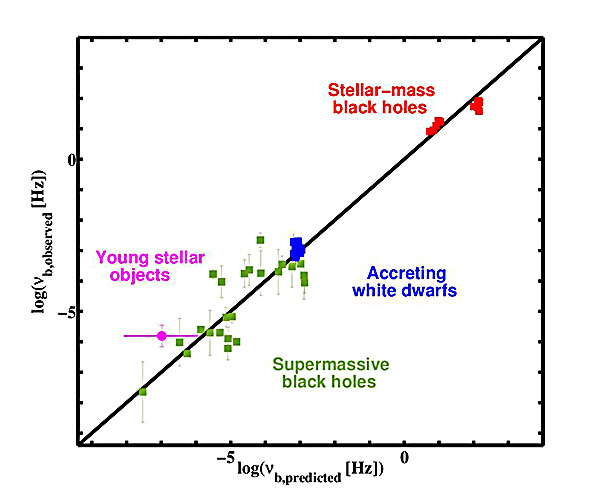ING web news release
16 October, 2015
Common Accretion across Young Stellar Objects, White Dwarfs, Black Holes and Supermassive Black Holes
An international team of astronomers, led by Dr Simone Scaringi of the Max-Planck-Institute for Extraterrestrial Physics, have discovered a previously
unknown link between the way young stars, white dwarfs and black holes grow feeding from their surroundings.
In a paper published in Science Advances, the authors show how the "flickering" in the brightness variations of young stellar objects (YSOs) - very young stars in the final stages of formation - is
similar to the flickering seen from ancient black holes or white dwarfs as they violently pull matter from their surroundings in a process known as accretion.
This observed flickering suggests that relatively cool accretion discs around young stars, whose inner edges can be several times the size of the Sun, show the same behaviour as the hot,
violent accretion discs around planet-sized white dwarfs, city-sized black holes and supermassive black holes as large as the entire inner Solar system.
The researchers discuss a unified scenario for understanding brightness variations from accretion disks around different types of stars and compact objects.
A previous work had unified the variability in disks around black holes of different mass ranges, but now, considering not just the mass of the object but also its size,
scientists can add accreting white dwarfs and proto-stars to this unified picture. Accretion therefore seems to be a universal process operating in a similar way despite the different size,
age, temperature and gravity of the accreted object.
|
 |
The universal plane for accretion-induced variability. The figure shows that the observed characteristic break frequencies, obtained from the power spectral density of various accreting systems,
agree very well with the predicted characteristic break frequencies. The predicted frequencies have been derived by inserting the observed masses, radii, and mass accretion rates
into the best-fit relationship to the combined supermassive black hole, stellar-mass black hole and accreting white dwarf sample. The figure additionally shows the position of the
young-stellar object V866 Sco with the filled magenta circle. This demonstrates that the variability plane of accreting systems extends from supermassive black holes all the way to young-stellar objects. Figure extracted from Scaringi, S. et al, 2015, Science Advances, 1, e1500686 [ JPG ].
|
The observations were obtained using the Kepler/K2 mission and ULTRACAM on different ground-based telescopes. Kepler/K2 is a NASA mission aimed at discovering Earth-size extrasolar planets in or
near the habitable zone through the transit method from very precise, long and uniterrupted lightcurves. ULTRACAM is an ultra-fast, triple-beam CCD camera designed to study
astrophysics on the fastest timescales. The ULTRACAM data were obtained at the 8.2-m Very Large Telescope (VLT) in Chile and the
4.2-m William Herschel Telescope (WHT). Both Kepler/K2 and ULTRACAM can "listen" to the seemingly random brightness variations produced by accretion discs,
revealing how they all sound the same once scaled by their physical size.
More information:
Scaringi, S., Maccarone, T. J., Koerding, E., Knigge, C., Vaughan, S., Marsh, T. R., Aranzana, E., Dhillon, V., Barros, S. C. C., 2015,
"Accretion-induced variability links young stellar objects, white dwarfs, and black holes", Science Advances, 1, e1500686. Paper.
"Young stars’ flickering light reveals remarkable link with matter-eating black holes",
University of Leicester press release, 13th July 2015.
"Shedding light on the growth of stars and black holes".
University of Southampton press release, 14th October 2015.
"New paper shines light on little-understood process in astronomy".
Texas Tech University press release,
9th October 2015.
Simone Scaringi is a Humboldt research fellow at the Max-Planck-Institute for Extraterrestrial Physics in Garching, Germany.
|
|



